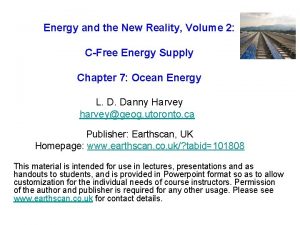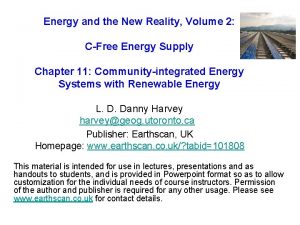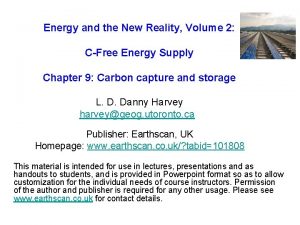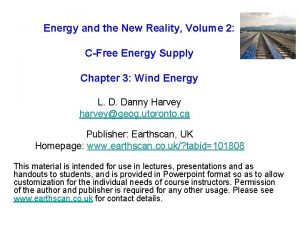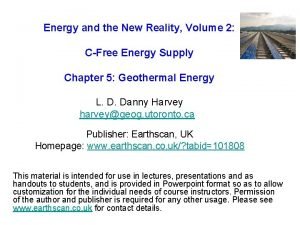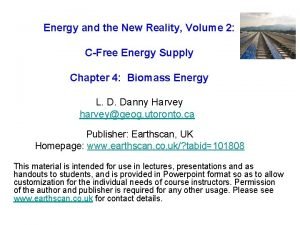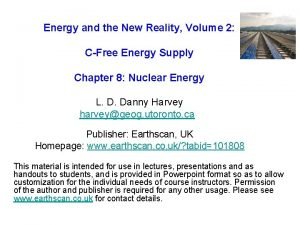Energy and the New Reality Volume 2 CFree








- Slides: 8

Energy and the New Reality, Volume 2: C-Free Energy Supply Chapter 11: Community-integrated Energy Systems with Renewable Energy L. D. Danny Harvey harvey@geog. utoronto. ca Publisher: Earthscan, UK Homepage: www. earthscan. co. uk/? tabid=101808 This material is intended for use in lectures, presentations and as handouts to students, and is provided in Powerpoint format so as to allow customization for the individual needs of course instructors. Permission of the author and publisher is required for any other usage. Please see www. earthscan. co. uk for contact details.

The concept of ‘Community-Integrated Energy Systems’ was introduced in Volume 1 (Chapter 9). These systems consist of one or more of: • A network of insulated underground pipes to distribute heat from various heat sources to where it is needed • A network of insulated underground pipes to distribute cold water from a central chilling facility or natural source of cold water to where it is needed • Cogeneration or a central heating plant • Trigeneration or a central cooling plant • Seasonal underground storage of heat or coldness

CIESs facilitate increased use of renewable energy in several ways: • Through the seasonal storage of solar thermal energy (collected during the summer, used during the winter) • By making it easier to use biomass or geothermal energy for heating of individual buildings (if a central heating plant and heat distribution network already exist) • By providing for flexibility in using intermittent electricity sources such as wind energy for heating or cooling with heat pumps combined with thermal energy storage • By facilitating the possible eventual transition to hydrogen for heating purposes

Figure 11. 1 Types of underground thermal energy storage (UTES) Source: Schmit et al (2004, Solar Energy 76, 165 -174, http: //www. sciencedirect. com/science/journal/0038092 X)

Figure 11. 2 Different arrangements of pipes in a borehole heat exchanger Source: Schmit et al (2004, Solar Energy 76, 165 -174, http: //www. sciencedirect. com/science/journal/0038092 X)

Supplemental Figure: Construction of a concrete seasonal thermal -energy storage tank in Friedrichshafen, Germany. Source: Fisch et al. (1998, Solar Energy 63: 355 -366, http: //www. sciencedirect. com/science/journal/0038092 X)

Supplemental Figure: Construction of a gravel/water pit for seasonal storage of solar heat, Steinfurt, Germany. Source: Pfiel and Koch (2000, Pfeil, M. and Koch, H. (2000, Solar Energy 69: 461 -467, http: //www. sciencedirect. com/science/journal/0038092 X)

Figure 11. 3 Components of a solar-assisted district heating system Source: Pahud (2000, Solar Energy 69, 495 -509, http: //www. sciencedirect. com/science/journal/0038092 X)
 Energy energy transfer and general energy analysis
Energy energy transfer and general energy analysis Energy energy transfer and general energy analysis
Energy energy transfer and general energy analysis Heart stroke volume
Heart stroke volume Factors affecting stroke volume
Factors affecting stroke volume Volume of solute divided by volume of solution * 100
Volume of solute divided by volume of solution * 100 Closing volume vs residual volume
Closing volume vs residual volume Volume kerucut = .....x volume tabung *
Volume kerucut = .....x volume tabung * Large volume parenterals examples
Large volume parenterals examples Hát kết hợp bộ gõ cơ thể
Hát kết hợp bộ gõ cơ thể









